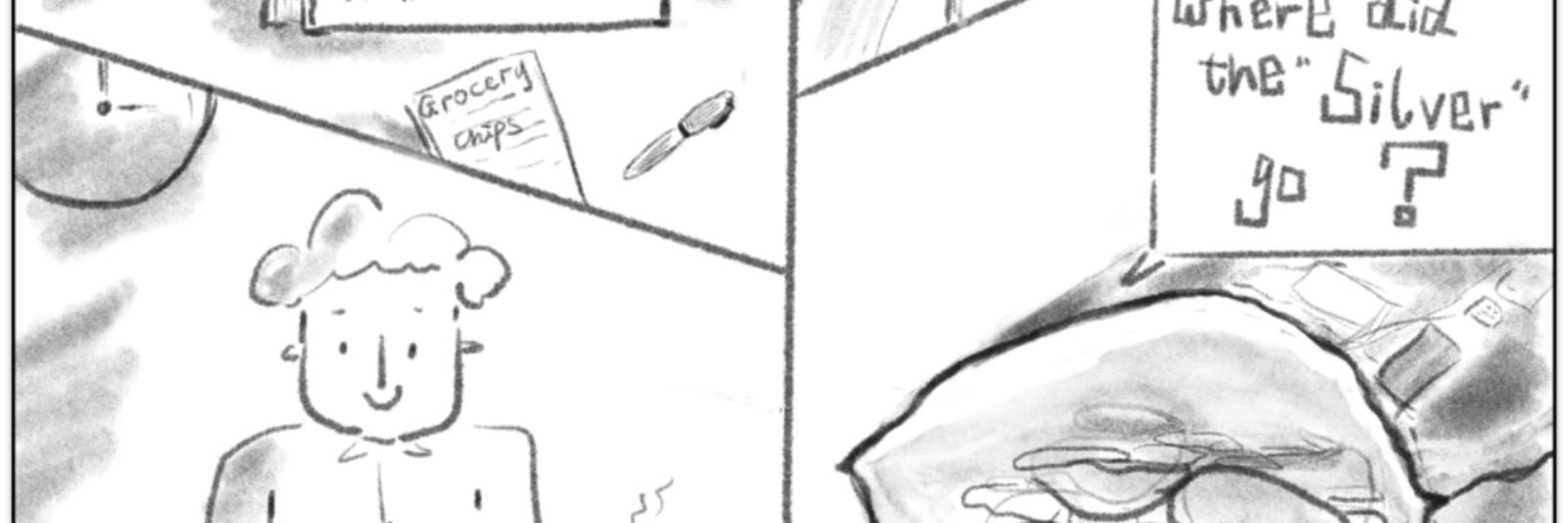17 May 2021

Future food packaging without aluminum
Illustration by: Jiaying Li

This project is a part of the ARC-CBBC multilateral research program Coatings. This research is mainly being conducted in the Membrane Surface Science group, University of Twente in close collaboration with Wageningen University & Research, BASF ,and AkzoNobel. The connection between academia and industry is the key to understand and further develop this new coating.
If you have noticed, most of the chip bags have a “silver” inner layer. Of course, it is not real silver, but aluminum-based. Metalized packaging protects food from oxygen in the air, to preserve the crunchiness of chips, the aroma of coffee beans, and in general, to prevent food from going bad. Although it has been serving this purpose, the biggest drawback lies in its poor recyclability. So, what can we do to change this?
Multilayer packaging as a problem
When you take a closer look at a piece of packaging, it is thin but much more complex than you think. Instead of one bulk layer that contains only one material, packaging is multi-layered, with different materials being laminated together. Every layer of these materials gives the packaging different desired functionality, in this case, aluminum as the gas barrier. Unlike those one-material-based bottles, how to efficiently sort, separate then recycle individual layers remains a technical challenge. As a fact, most of these multi-layer packaging goes to landfills or incineration, which is undoubtfully bad for the environment.
Why polyelectrolytes?
Scientists are working on this problem, trying to avoid the use of multi-layer packaging or reduce the layers. The solution lies in polymers. Since the majority of the packaging is already polymer-based, we just need to add the functionalities, such as the gas barrier. This project as one of them has a unique twist. We are no longer working with traditional polymers that are only soluble in organic solvents, but we are working on polyelectrolytes. A special class of polymers that dissolves in water. Grab your salt on the table. The major component is NaCl, in which the force between Na+ ions and Cl– ions is an ionic interaction. Same as salt, the charges on polyelectrolytes also have this interaction. When a positively charged polyelectrolyte binds with a negatively charged polyelectrolyte, we call this a complexation.
The biggest advantage of this interaction is that it is reversible. Plastics that form permanent chemical bonds give good properties but result in the plastic crisis that we are all in. On the contrary, this ionic interaction can be increased, reduced or completely removed by playing with different parameters. In the ideal case, this polyelectrolyte coating has sufficient strength for daily use and can be deformed afterward.
How do we make and unmake the coating?
Polyelectrolyte-based coatings are not new. Scientists are using a technique to make polyelectrolyte coatings – the Layer-by-Layer method. This method is repeating dip coating, similar to lasagna. Depending on the density of the final multi-layer, it can be used as a membrane to purify water or a barrier against gas. However, the major drawback is that every layer of this lasagna takes around 30 min to make. Thus, industrializing this method is difficult.
Instead of this tedious approach, our method can make a coating in one step, which can cover a much bigger surface, meanwhile, reduce the time needed significantly. We start with preparing a liquid, just like a can of paint. This liquid has both positively and negatively charged polyelectrolytes, but we temporarily blocked their interaction. Only during the drying, the complexation starts that forms the dense layer. Then, it is ready for use. After it eventually serves the purpose and ends in the dustbin, how do we recycle this coating? By simply introducing the starting conditions again, the complex falls apart and dissolves back into the liquid form. Another advantage is that no nasty organic solvents are used that everything is performed in water. With this one step approach, we believe that it brings polyelectrolytes much closer to be industrialized.
Does it work as an oxygen barrier?
Yes, it does. Previous research has shown that this kind of materials have excellent oxygen barrier properties. Our preliminary result also shows it has great potential to be used in packaging to protect food from oxidation. Now, we are also focused on improving other properties, such as water resistance and mechanical stability.
There is more
At this moment, this method is proven to work for the synthesized polyelectrolytes. Our next goal is to use bio-derived polyelectrolytes. These polyelectrolytes are 100% natural-based, for example, extracted from shrimp shells or trees. Moreover, while we are working towards this gas barrier application, we are also searching for other functionalities. With the versatility of natural polyelectrolytes, we are pacing to the era that we become less dependent on synthesized polymers. This project as a close collaboration between universities (University of Twente and Wageningen University & Research) and companies (BASF and AkzoNobel) is really aiming at bridging the gap between pure research and what can it give back to the society.
To sum it up, this polyelectrolyte coating serves the same purpose, less shiny, but makes recycling easier. By removing the metal layer, there are easier and fewer procedures required to recycle these multi-layer packaging. The potential oxygen barrier property of this coating has been proven. More research is required to further develop the properties and slowly transit to use bio-based polyelectrolytes. Hopefully, in the near future, we will no longer find the “silver” in our food packaging.
The author would like to acknowledge Wiebe M. de Vos (University of Twente), Jasper van der Gucht (Wageningen University & Research), Derk Jan van Dijken (BASF) and Gerard van Ewijk (AkzoNobel).
This work is part of the Advanced Research Center for Chemical Building Blocks, ARC CBBC, which is co-founded and co-financed by the Dutch Research Council (NWO) and the Netherlands Ministry of Economic Affairs and Climate Policy.
